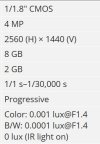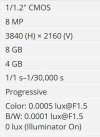Robertomcat
Active Member
- Messages
- 47
- Points
- 8
Hello, good afternoon.
I have a doubt when it comes to choosing a camera from all the ones I have already discarded, but of these last two I have left to choose from, I would like to know which of the two receives a better image in low light conditions in colour mode.
The two models are from Dahua, and after looking at Hikvision models, these are the ones I like the most. Which of these two configurations would be ideal for my question? Thank you.
I have a doubt when it comes to choosing a camera from all the ones I have already discarded, but of these last two I have left to choose from, I would like to know which of the two receives a better image in low light conditions in colour mode.
The two models are from Dahua, and after looking at Hikvision models, these are the ones I like the most. Which of these two configurations would be ideal for my question? Thank you.



